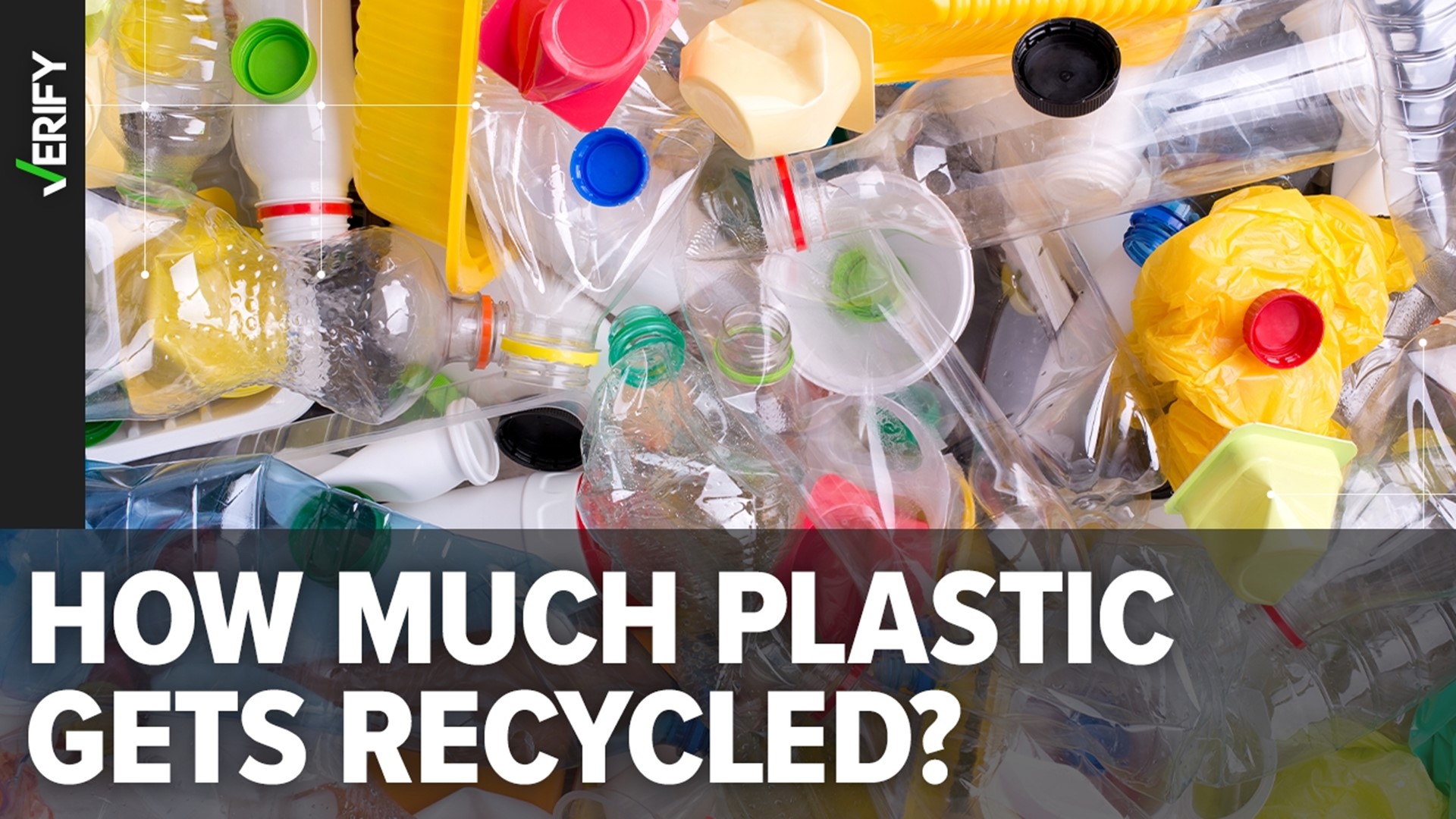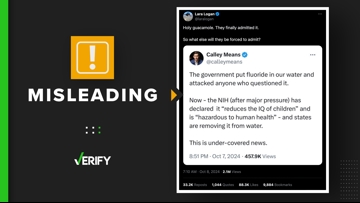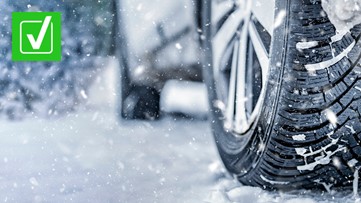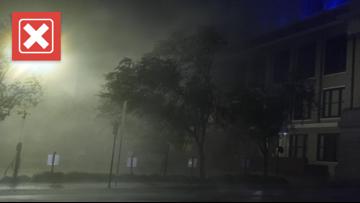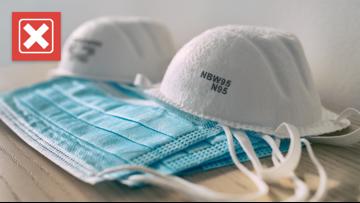People have long been told that recycling is an effective way to prevent pollution and help the environment. But rumors that the plastics you put in the recycling bin wind up in a landfill instead have been around for almost as long.
Many stories and headlines about plastic recycling frequently share statistics that only 5% to 9% of plastics are actually recycled. Many VERIFY readers have reached out to us to ask if the plastic they’re putting in the recycle bin is winding up in landfills instead.
THE QUESTION
Does less than 10% of plastics put in recycle bins actually get recycled?
THE SOURCES
Recycle Smart MA, an education initiative funded by the Massachusetts Department of Environmental Protection (MassDEP)
Recycling Partnership, a non-governmental organization formed to advance and improve recycling systems
Organisation for Economic Co-operation and Development (OECD)
Global Alliance for Incinerator Alternatives (GAIA), a nonprofit organization with a focus on waste and pollution
Recycling programs in several cities, including Washington, D.C.; Salt Lake City, Utah; Chicago, Illinois; San Francisco, California; Denver, Colorado; and Charlotte, North Carolina
Kara Pochiro, the vice president of communications and public affairs for the Association of Plastic Recyclers
Brent Bell, vice president of recycling operations for WM
THE ANSWER
No, it’s not true that less than 10% of plastics put in recycle bins actually get recycled. The 5-9% figures that are commonly cited reference the total amount of plastics that end up getting recycled, most of which are thrown in the garbage, not the percentage that is actually sent to a recycling facility.
WHAT WE FOUND
Based on the available data, most plastics that get collected for recycling do get recycled. This is especially true of certain types of plastics that are universally recyclable, like water bottles.
However, the vast majority of plastics don’t get collected for recycling and are thrown away instead. That is where the 5-9% statistics come from.
The Environmental Protection Agency (EPA) estimated that about 9% of all plastic waste was successfully recycled in 2018. Researchers at the National Renewable Energy Laboratory (NREL) estimated that approximately 5% of all plastic waste was recycled in 2019. These statistics, which are the most recent available, are based on all plastic waste generated, which includes plastics that cannot be recycled and those that were thrown away.
Many plastics are difficult or impossible to recycle. Some plastics aren’t recyclable because they are so small they’ll fall into crevices within the recycling machinery, Clean River Recycling Solutions says. Many single-use plastics aren’t recyclable because they would have to rely on a process called chemical recycling, which Clean River says we don’t have the ability to do at scale in the United States.
But some plastics that are easy to recycle are thrown away at home more often than they’re recycled.
As for the plastic that makes it to the recycling center, there isn’t an official nationwide estimate of what percent of those plastics get recycled in the end. The numbers available globally and locally, however, suggest that the majority of recyclable plastics sent to recycling centers actually do get recycled.
The Organisation for Economic Co-operation and Development (OECD) says 60% of plastic collected for recycling worldwide in 2019 was actually recycled — but only 15% of all plastic waste was collected for recycling in the first place.
The recycling rate for collected plastics can vary widely in different states and municipalities.
Recycle Smart MA, an education initiative funded by the Massachusetts Department of Environmental Protection (MassDEP), says that 90% of the state’s recyclable plastic actually tossed into a blue bin “will be sold to recycling reclaimers to begin their next life.”
Salt Lake City’s recycling program claims to have even better numbers. The city says 99% of the plastics it collects for recycling are actually recycled instead of burned for fuel or sent to landfill.
Recycling centers generally don’t like sending things to landfills because it means they’re selling less recycled material. Kara Pochiro, the vice president of communications and public affairs for the Association of Plastic Recyclers, told VERIFY the “vast majority” of recyclable materials you put in your bin get recycled.
Brent Bell, vice president of recycling operations for WM, told VERIFY in an email that the company tries to recycle everything its facilities can recycle.
“Generally, we expect to recycle all clean and dry materials from our list of accepted recyclables,” Bell said.
But some of what people toss into their blue bins aren’t recyclable, so a small portion does end up going to a landfill as a result of mis-sorting or contamination, Recycle Smart MA says.
Stuff that can’t be recycled because it’s either unrecyclable material or is otherwise contaminated have to be thrown out instead. A recyclable item can be contaminated if it isn’t cleaned of residue or can’t be separated from unrecyclable material. This can happen to any recyclable, not just plastics.
In 2019, the average contamination rate for all materials at recycling programs across the U.S. was 16.9%, according to the 2020 State of Curbside Recycling report by the Recycling Partnership, a non-governmental organization formed to advance and improve recycling systems.
Bell said WM sees a 16-18% contamination rate on average across all materials including glass, metal and paper in the company’s recycling programs.
These numbers can vary from community-to-community, particularly when it concerns plastics. Global Alliance for Incinerator Alternatives (GAIA), a nonprofit organization with a focus on waste and pollution, studied waste management in Baltimore, Detroit, Long Beach, Minneapolis and Newark in 2021. GAIA found that 12-55% of all plastics collected for recycling in these cities was not recyclable.
Each municipality may also be able to collect and recycle different plastics based on their local facilities, which can affect whether a plastic is considered recyclable in their community.
Which plastics are actually recyclable?
What’s recyclable depends on the facilities and equipment at your local recycling centers, so there is no single answer nationwide. However, there are some plastics that are almost always recyclable and others that are almost always not.
Pochiro said you can be “close to 100% confident” that your local recycling program will accept PET bottles like plastic soda bottles and water bottles, as well as laundry detergent bottles and milk jugs you buy from the grocery store.
Bell said plastic bottles are accepted in nearly every local recycling program. VERIFY checked the recycling programs of a number of different cities around the U.S. and consistently found plastic bottles among the things they accept.
Even though almost every program accepts plastic PET bottles, the recycling rate of PET bottles and jars was 29.1% in 2018, according to the EPA. That’s because most people throw away their bottles instead of recycling them.
You have to check what your local recycling program accepts for most other kinds of plastics. For example, many cities, such as Chicago and San Francisco, accept clean plastic “clamshell” food containers for recycling, but others, such as Charlotte, will not.
“It would be a lot easier if every single community took the same things to get recycled, but they just have different infrastructure and it's just not possible now,” Pochiro said. “But that's something we're working towards, of course.”
There are some plastics most recycling programs won’t accept — top of that list being plastic grocery bags. Denver says these bags are the city’s “#1 recycling contaminant.”
“Do not recycle loose plastic bags (as most single-stream recycling programs do not accept plastic film), and do not bag your recyclables,” Bell said. He suggested that you can instead take your grocery bags and other plastic film back to the retailer if it has front-of-the-store, take-back initiatives.
Sometimes, plastic bags can damage recycling and sorting equipment by getting caught within them and clogging them up, Salt Lake City says.
But it’s still worth checking with your local recycling programs, even for plastic bags since a few cities can handle and recycle them.
Houston has a program to collect and recycle “plastic waste that is considered difficult to recycle,” including plastic bags. And Bell said WM is working on developing programs to make it easier to recycle plastic bags.
“We are working with companies as well as developing pilot programs to make it easier for consumers to recycle plastic film, which currently is not accepted in single-stream programs,” Bell said. “We are also investing in technology in our facilities to help us pull the film out so that we can help create viable markets for repurposing the material.”
This story is also available in Spanish / Lee este artículo también en español: Lo que podemos verificar acerca de cuánto plástico es realmente reciclado
